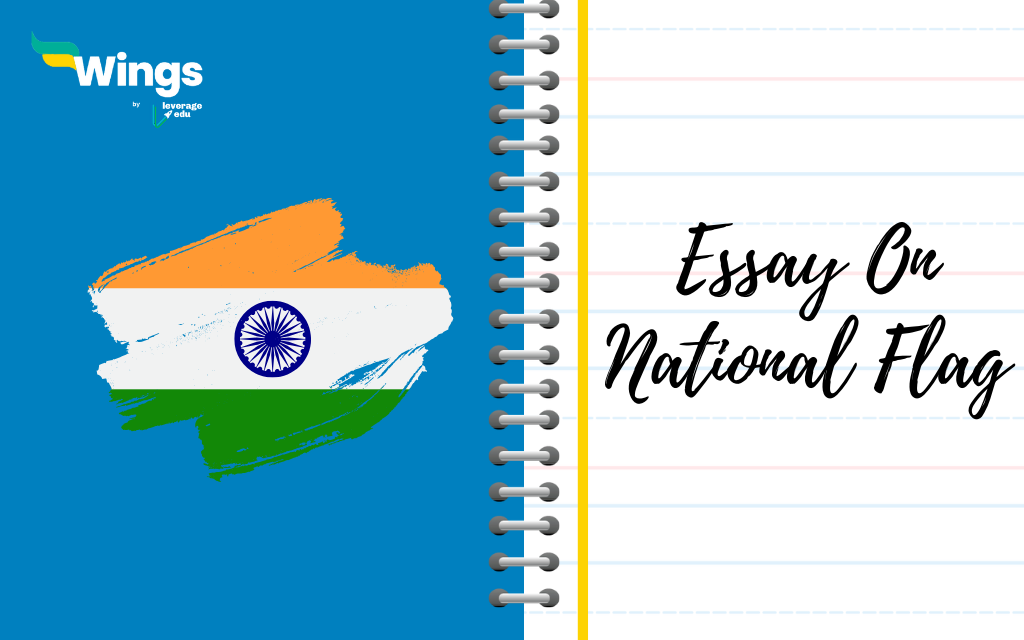The National flag of India is a symbol that represents India’s freedom as well as its integrity. It represents that India is governed by the people of the country without any foreign interference. The display of the Indian flag is our pride and it is a warning to the invaders. Our Nation flag is based on the Swaraj Flag which was designed by Pingali Venakyya. The tricolour display is governed by the Flag code of India and any act of dishonour to the flag is a punishable offence. This is just a brief paragraph on the national flag. Below we have provided samples of essays on National Flag. let’s have a look at them.
Contents
Also Read:- Essay on Pollution
Essay on National Flag in 100 words
The National Flag is a symbol of pride and unity for every country. In India, our National Flag is called the Tricolor, or Tiranga, because it has three horizontal stripes of different colors. The top stripe is saffron, which represents courage and sacrifice. The middle stripe is white, symbolizing peace and truth, with a navy blue Ashoka Chakra in the center. This chakra has 24 spokes, signifying progress and justice. The bottom stripe is green, representing growth and prosperity.
The Indian National Flag was designed by Pingali Venkayya and adopted on 22nd July 1947. It reminds us of the sacrifices made by our freedom fighters and inspires us to uphold the values of our country. We must respect the flag by not letting it touch the ground or get dirty. On important days like Republic Day and Independence Day, we proudly hoist the flag to honor our nation.
Essay on National Flag in 250 words
Our national flag was adopted on July 22nd, 1947, which was some days before the Independence of India i.e. 15th August 1947. The national flag of India is called the Tiranga because it contains 3 colours. The Uppermost colour is saffron which symbolises selflessness and sacrifice. The middle one is white which symbolises the truth. Purity and peace. And the lowermost colour is green which indicates energy and youth. In the middle of the white stripe, there is a navy blue colour Ashok Chakra that is made up of 24 equal spokes. The National flag of India symbolises freedom, pride, honour, and unity. The Ashoka Chakra is a symbol of victory justice and honesty.
Our national flag not only represents us but also teaches us some lessons such as peace, unity, humanity, etc. It helps us believe in unity and truth. Every year, the Prime Minister of India hoists the National Flag of India on the 15th of August and the same is hoisted by the President of India on the 26th of January. Both of them hoist the flag at the Red Fort which is then followed by an address to the people of India. Our national flag is made of Khadi, which is an article of hand-made clothing that was represented by Mahatma Gandhi. Flying off the national flag made up of clothes other than Khadi is strictly prohibited in our country. We should hoist our National Flag with pride and let the world know about the same.
Also Read:- Importance of Internet
Essay on the National Flag in 500 words
The National Flag is the pride and identity of every nation. It represents the unity, values, and history of the country. In India, the National Flag is called the Tricolor or Tiranga because it has three horizontal stripes of different colors.
Design of the Indian National Flag
The Indian National Flag consists of three equal horizontal bands:
- Saffron at the top symbolizes courage, sacrifice, and strength.
- White in the middle represents peace, truth, and purity.
- Green at the bottom signifies growth, prosperity, and fertility.
In the center of the white band, there is a navy blue Ashoka Chakra, a wheel with 24 spokes. The Ashoka Chakra stands for progress, righteousness, and the eternal cycle of life. It is inspired by the Lion Capital of Ashoka at Sarnath and reminds us of the teachings of dharma (justice).
History of the Indian Flag
The journey of the Indian flag began during the struggle for independence. The first Indian flag was hoisted in 1906 in Kolkata. It had three horizontal stripes of green, yellow, and red, with symbols like the sun and moon. Over the years, the design evolved. The present Tricolor was designed by Pingali Venkayya, a freedom fighter from Andhra Pradesh. It was adopted on 22nd July 1947, just before India gained independence on 15th August 1947.
Importance of the National Flag
The National Flag is more than just a piece of cloth. It is a symbol of the sacrifices made by countless freedom fighters who fought for the independence of India. It inspires patriotism and reminds us of our responsibility to uphold the values of democracy, justice, and equality.
The flag also serves as a unifying force, bringing together people from diverse cultures, languages, and religions under one identity – Indian. During important occasions like Independence Day, Republic Day, and other national celebrations, the flag is hoisted with great respect and honor.
Flag Code of India
The Flag Code of India provides guidelines on how the National Flag should be displayed and respected. Some important rules are:
- The flag should always be hoisted in a position of honor and should never touch the ground.
- It should not be used as a drapery or for decoration.
- Damaged or torn flags should not be displayed. They must be respectfully disposed of by burning.
- Citizens can hoist the flag at their homes, offices, and institutions on any day, but they must follow the guidelines set by the Flag Code.
Interesting Facts about the Indian National Flag
- The Ashoka Chakra has 24 spokes, symbolizing the 24 hours in a day and the importance of constant progress.
- The flag was first hoisted on 15th August 1947 at the Red Fort in Delhi by Prime Minister Jawaharlal Nehru.
- Khadi, a hand-spun fabric promoted by Mahatma Gandhi, is used for making the Indian National Flag.
- The largest Indian flag, measuring 225 feet by 150 feet, was hoisted in Belagavi, Karnataka, in 2021.
Conclusion
The Indian National Flag is a symbol of pride, unity, and independence. It reminds us of our rich history and the sacrifices made by our leaders for a free India. As responsible citizens, it is our duty to respect and protect the flag. Let us always honor the Tiranga and strive to uphold the values it represents.
10 Important Lines on National Flag
Here are 10 important lines on the National Flag:
- The National Flag of India is called the Tiranga or Tricolor.
- It has three horizontal stripes: saffron, white, and green.
- The saffron color represents courage and sacrifice.
- The white color symbolizes peace and truth.
- The green color stands for growth, prosperity, and fertility.
- In the center of the white stripe, there is a navy blue Ashoka Chakra with 24 spokes.
- The Ashoka Chakra represents progress and justice.
- The flag was designed by Pingali Venkayya and adopted on 22nd July 1947.
- It is a symbol of India’s unity, pride, and independence.
- We must always respect the flag by following the Flag Code of India and handling it with care.
FAQs
Ans: Our National flag is the pride of our nation. It symbolises the unity of the people of India belonging to different religions. The honour and respect for our country and its national flag should be immense from us. Every country has a national flag. Our National Flag is called ‘Tiranga’ which is based on its appearance as a tricolour. The saffron colour is the topmost, the middle colour is white and the lowermost colour is green. There is a navy blue Ashok Chakra in the middle stip of white colour which contains 24 equally divided spokes.
Ans: The National flag of India is a symbol that represents India’s freedom as well as its integrity. It represents that India is governed by the people of the country without any foreign interference. The display of the Indian flag is our pride and it is a warning to the invaders.
The significance of the national flag is great to us all. It is the pride of the nation and the pride of every citizen of India as well. All the elements as well as colours used in the national flag have special significance and depict something.
Ans: The Nation flag of India is a symbol that represents India’s freedom as well as its integrity. It represents that India is governed by the people of the country without any foreign interference. The display of the Indian flag is our pride and it is a warning to the invaders. Our Nation flag is based on the Swaraj Flag which was designed by Pingali Venakyya. The tricolour display is governed by the Flag code of India and any act of dishonour to the flag is a punishable offence.
Ans: The Indian National Flag, known as the Tiranga, consists of three horizontal stripes:
Saffron (top): Symbolizes courage and sacrifice.
White (middle): Represents peace, truth, and purity.
Green (bottom): Signifies growth, prosperity, and fertility.
In the center of the white band is a navy blue Ashoka Chakra with 24 spokes, representing the eternal wheel of law.
Ans: The flag was designed by Pingali Venkayya, a freedom fighter from Andhra Pradesh.
It was adopted in its present form during a meeting of the Constituent Assembly held on 22 July 1947, and it became the official flag of the Union of India on 15 August 1947.
The Flag Code of India outlines specific guidelines for displaying the National Flag:
– The flag should always be hoisted in a position of honor and should never touch the ground.
– It should not be used as a drapery or for decoration.
– Damaged or soiled flags should not be displayed; they must be disposed of in a dignified manner, preferably by burning.
– Citizens can hoist the flag at their homes, offices, and institutions on any day, but they must follow the guidelines set by the Flag Code.
Popular Essay Topics
For more information on such interesting topics, visit our essay writing page and follow Leverage Edu.
 One app for all your study abroad needs
One app for all your study abroad needs














